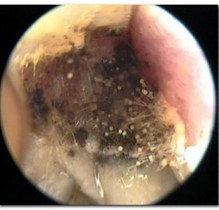OUTER EAR INFECTIONS
Outer ear infections, or swimmer’s ear, can turn fun in the sun into a real ear-bummer. They happen when water gets trapped in the ear canal, making it the perfect place for germs to throw a party.
TYPES
- Acute External Otitis (Swimmer’s Ear): Inflammation or infection in the ear canal.
- Chronic External Otitis: Long-lasting inflammation or infection in the ear canal.
CAUSES
BACTERIAL INFECTIONS
Pseudomonas aeruginosa and Staphylococcus aureus are commonly involved.
FUNGAL INFECTIONS (OTOMYCOSIS)


Candida and Aspergillus species are common culprits, causing ear canal infection in Singapore.
ENVIRONMENTAL FACTORS
Excessive moisture or minor trauma to the ear canal can trigger infection. These infections are common in swimmers and those who dig their ears with cotton buds or other instruments.
MANAGEMENT
EAR CLEANING
To remove any debris or discharge. Ear toilet under a microscope is a pivotal procedure in treating ear infections. It enables targeted removal of infected material and debris, reducing the bacterial/fungal load while minimizing risk of trauma to sensitive ear structures, including the eardrum. It also facilitates accurate sample collection for microbiological analysis, aiding in targeted antibiotic therapy.
TOPICAL ANTIBIOTICS OR ANTIFUNGALS
Topical antibiotics or antifungals in the form of ear drops and creams are often the first line of treatment for outer ear infections. Dr Sandeep Uppal and his team at The ENT Clinic frequently prescribe these as they directly target the underlying microorganisms, offering rapid relief from symptoms. Ear drops are generally easier to administer, while creams may provide a longer-lasting effect on the affected area. Both forms are effective in eradicating the infection when used as directed.
PAIN MANAGEMENT
Over-the-counter analgesics or stronger medications are used where necessary.
COMPLICATIONS
Complications arising from untreated or improperly managed outer ear infections are a concern that Dr Sandeep Uppal and his team at The ENT Clinic take seriously. Here are some key complications associated with outer ear infections:
- Cellulitis: The infection may spread to adjacent skin and soft tissue, requiring more aggressive treatment, such as intravenous antibiotics.
- Chronic External Otitis: Persistent infections can lead to a chronic state, increasing the risk of further complications and often requiring long-term treatment.
- Stenosis: Repeated or chronic infections can result in a narrowing of the ear canal, potentially affecting hearing and making future treatments more challenging.
- Abscess Formation: Pockets of pus may develop, requiring drainage and more intensive antibiotic therapy.
- Malignant Otitis Externa: Though rare, this severe form of outer ear infection can spread to the bones and cartilage at the base of the skull, requiring immediate medical intervention. This is more likely to happen in patients who have uncontrolled diabetes mellitus or are immunocompromised.
- Hearing Loss: While usually temporary, untreated outer ear infections can sometimes result in conductive hearing loss.
Dr Sandeep Uppal and his team are adept at identifying the signs of these complications early, thanks to their meticulous diagnostic approach, thereby enabling timely and effective interventions.
GOODBYE EARACHES!
Is the splash of summer fun leaving you or your little one with an itchy or aching ear?
We’re here to help you and your child hear without any ouches. No more ear pain means more fun talking and playing. We’re all about keeping ears feeling good and working great.
Don’t let swimmer’s ear dampen your spirits or silence your conversations. Our team is all about more than just quick fixes—we aim to ensure everyone enjoys the full symphony of sounds life has to offer, without any interruptions.




